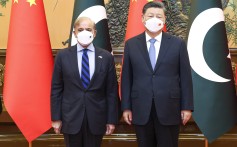muhammadhafeezmalik
SENIOR MEMBER

- Joined
- Jan 21, 2015
- Messages
- 5,414
- Reaction score
- -17
- Country
- Location
China's railroad to world domination: $58 billion rail link with Pakistan will reduce reliance on West
Chinese rail review board says system connecting Pakistan to China will change trade and geopolitics
China has proposed its most expensive Belt and Road Initiative to date with a $58 billion railway system that would connect Pakistan to western China in a move to further reduce Western trade dependence, a report said Thursday.
The $57.7 billion plan was reviewed by analysts from the state-owned China Railway First Survey and Design Institute Group Co Ltd., which has determined that despite its hefty price tag the investment is worth it, reported the South China Morning Post.
The 1,860-mile rail system will connect Pakistan’s port of Gwadar to the Chinese city of Kashgar in the Xinjiang Uygur autonomous region and has the potential to reshape not only trade but geopolitics, according to the proposal’s review board.

A train equipped with coaches imported from China arrives at a railway station in Islamabad, capital of Pakistan, Jan. 27, 2023. (Ahmad Kamal/Xinhua via Getty Images)
HOUSE REPUBLICAN PROPOSES BILL TO LET AMERICANS SUE FOREIGN COUNTRIES LIKE CHINA, MEXICO OVER FENTANYL
"The government and financial institutions should provide strong support, increase coordination and collaboration among relevant domestic departments, strive for the injection of support funds and provide strong policy support and guarantees for the construction of this project," the Chinese team of analysts said in a report published earlier this month in the Chinese journal, Railway Transport and Economy.
Though the railway connecting China to Pakistan would be China’s biggest transport project yet, this is not the first major international rail system the Institute has been involved in, having helped with Jakarta-Bandung high-speed rail line in Indonesia – Asia’s first high-speed rail system – which is slated to open in June.

Passengers purchase tickets for the China-Laos Railway in Vientiane, Laos, April 11, 2023. (Yang Yongquan/Xinhua via Getty Images)
CHINA 'RECOGNIZES MEXICO’S STRATEGIC VALUE' AS IT EYES GREATER INFLUENCE WITH US NEIGHBOR
The latest rail system to get the green light in China will connect the world’s top manufacturer with the Arabian Sea, opening it up to more direct trade routes.
It is also expected to encourage additional train systems that could connect China to Turkey and Iran – significantly opening up direct access to the regions, reported the South China Morning Post.

Foreign ministers from China, Russia, Iran and Pakistan meet in Samarkand, Uzbekistan, on April 13, 2023. (Bai Xueqi/Xinhua via Getty Images)
The trade routes are just one component of Beijing’s broader Belt and Road Initiative that looks to solidify China as a world superpower and encourage global domination in the trade sector.
The initiative is also looking to shift focus away from historical trade routes dominated by Western nations to better improve China's economic goals and encourage a "multipolar world" to diminish Western power – a move that top autocratic nations like Russia and Iran have also been eager to encourage as geopolitical tensions with the West continue to escalate.

China's railroad to world domination: $58 billion rail link with Pakistan will reduce reliance on West
China has proposed its most expensive Belt and Road Initiative yet with a $58 billion railway system that would connect Pakistan to western China in a move to further reduce Western trade dependence.








